On a sunny morning this week, we pulled up to a thin walkway, between suburban houses, that entered the cool shade of Miller Creek. Located just off the 101 off Lucas Valley Road in Marin County, at this reach in its meanderings, Miller Creek and its riparian corridor pass just behind a school. Soon, sixth graders from Miller Creek Middle School would pour out of class and into the trees behind their school to continue a tradition of restoring and taking care of their local creek.
A collaboration between Marin County Stormwater Pollution Program (MCSTOPP) and Students and Teachers Restoring A Watershed (STRAW), these creek restoration days are the hands-on part of an educational effort to connect “riparian restoration concepts to stormwater pollution prevention and to creek habitat protection.” After in-class learning, the students come to the creek to remove invasive plants, non-native plants that aggressively take-over other plants’ habitats, to plant native plants that will provide habitat for animals and prevent erosion, and to stabilize creek walls.
The night before coming to Miller Creek, I read up on stormwater pollution and riparian restoration and learned some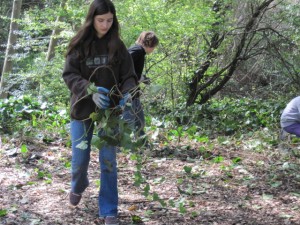 interesting facts. The most enlightening was that preventing stormwater pollution is especially important because almost all stormwater leads directly to creeks, the Bay, and the ocean. Water that goes down a drain in your house goes to a treatment plant before entering a natural body of water. Not stormwater. In other words, any litter, chemicals, or soap that go into the gutter, go into your local creeks and the ocean. So, it is super important to prevent anything but pure stormwater from flowing into storm drains.
interesting facts. The most enlightening was that preventing stormwater pollution is especially important because almost all stormwater leads directly to creeks, the Bay, and the ocean. Water that goes down a drain in your house goes to a treatment plant before entering a natural body of water. Not stormwater. In other words, any litter, chemicals, or soap that go into the gutter, go into your local creeks and the ocean. So, it is super important to prevent anything but pure stormwater from flowing into storm drains.
As the first classes poured into the trees, the sixth graders were split up to work on different projects. My colleague Vivien, who works with MCSTOPP, and I led our first group of eight students to a clearing upstream of the other groups. English Ivy, an invasive plant that is home only to rats, and is so noxious that no animals eat it, covered the area. Vivien instructed the students to kneel on the ground and slowly and carefully pull the Ivy from the ground, trying to get as much of the root as possible so that it wouldn’t return. He then demonstrated how to use two tools, a weed-puller and a mattock, a small pick, that would help yank the roots of any stronger plants up. And then he set us loose.
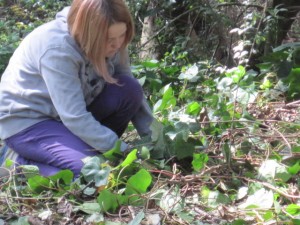 Sounds easy enough right? During that first group I got an idea of why English Ivy is an invasive plant. An interconnected tangle of plants that roots its branches wherever it can and can have its main root yards away from the ends of its vines, I could see why they instruct the kids to be slow and careful about work. My first instinct was to attack and rip at the tangled monstrosity of plants in front of me. Just trying to find where a branch went into the ground was challenging. But reigning in my impatience and wanting to be a good roll-model, I figured out a method of pulling that seemed to be most effective. Patience. Working with what’s right in front of you. Being content with removing one small root at a time.
Sounds easy enough right? During that first group I got an idea of why English Ivy is an invasive plant. An interconnected tangle of plants that roots its branches wherever it can and can have its main root yards away from the ends of its vines, I could see why they instruct the kids to be slow and careful about work. My first instinct was to attack and rip at the tangled monstrosity of plants in front of me. Just trying to find where a branch went into the ground was challenging. But reigning in my impatience and wanting to be a good roll-model, I figured out a method of pulling that seemed to be most effective. Patience. Working with what’s right in front of you. Being content with removing one small root at a time.
Throughout the day, Vivien and I worked with five different groups of sixth-graders, watching as the Ivy’s borders retreated. At the end of the day, the truck was filled with around three cubic yards of Himalayan blackberry and Ivy from everyone’s effort. It was rewarding work. And especially rewarding to watch different students work together to get massive trunks of Ivy from the ground. My personal favorite was watching as a group of girls, a few of them in pretty slip-on shoes and pink flip-flops hunkered down in the dirt, using 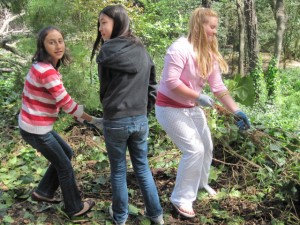 their collective strength to pull out branches of Ivy we’d been having trouble with all day long. It was a joy to watch a small group of humans band together to take care of the environment, to be connected to it.
their collective strength to pull out branches of Ivy we’d been having trouble with all day long. It was a joy to watch a small group of humans band together to take care of the environment, to be connected to it.
As I watched five different groups of kids approach the mass of Ivy in the same way I had (wanting to rip through the tangle impatiently and play tug-of-war with long vines that would break without giving their roots up), I began to see Ivy as the perfect metaphor for humans’ relationship with the environment at the moment. An interconnected tangle of problems that will not take a quick fix, the Ivy, like our ecosystem problems, requires patience, working with what is right in front of us, satisfaction with small victories, and a commitment to removing the root of the problem, not ripping at branches haphazardly and mindlessly. One Ivy root at a time.
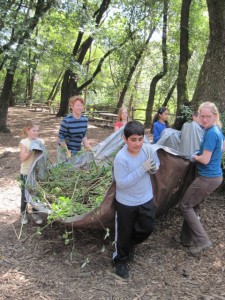 Thank you to MCSTOPP and STRAW for your amazing work! And thank you to Ericka from the California Water Quality Control Board for letting me tag along!
Thank you to MCSTOPP and STRAW for your amazing work! And thank you to Ericka from the California Water Quality Control Board for letting me tag along!

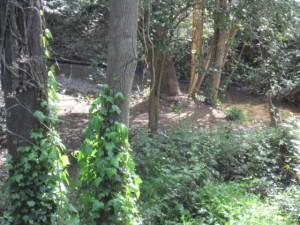
Excellent insight of English Ivy removal as a metaphor for tackling our collective environmental problems! Thanks so much for your help in the field and for writing so eloquently about the day.
Absolutely beautiful piece, Carly, a look at how children can be directly involved in making sense of their world (actually that’s the only way they can do such).
It’s so important for us to learn as a society that we get very little of value accomplished when we scurry and hurry frantically about and ignore the root of our problems.
I’ve learned over the years as an educator that children adapt to such theories easily when they’re given the opportunity to think critically.
Thanks for highlighting the work these young people are doing and thanks for your wonderful contributions to the making of a more understanding world.